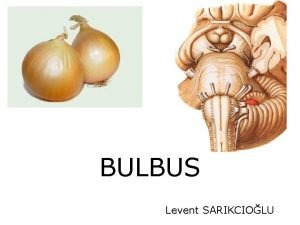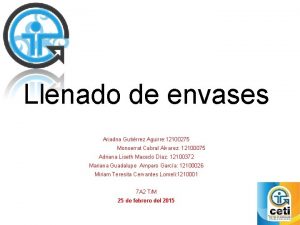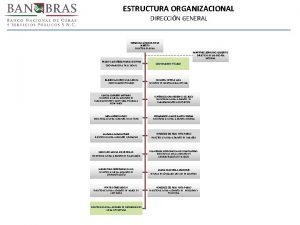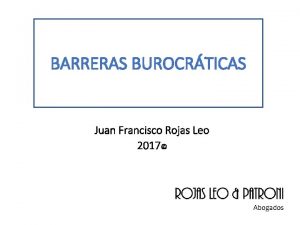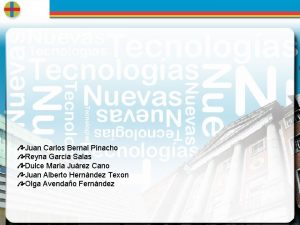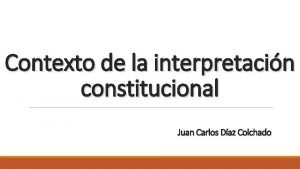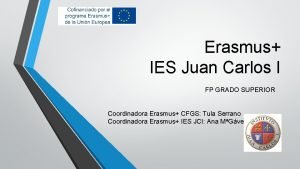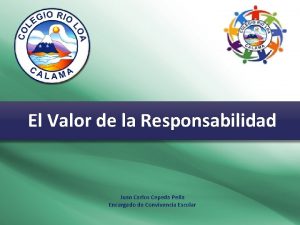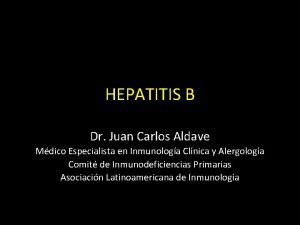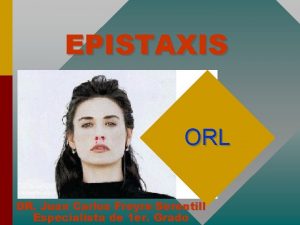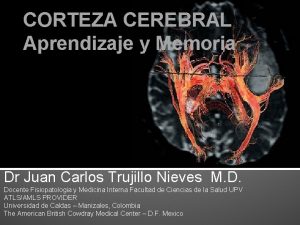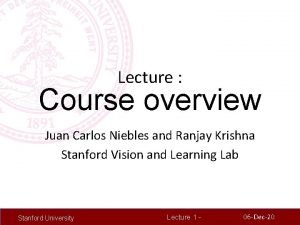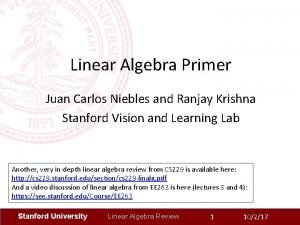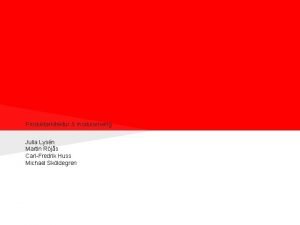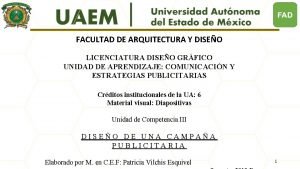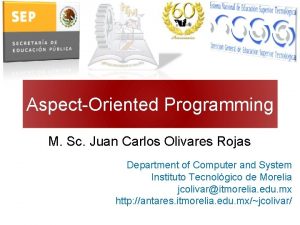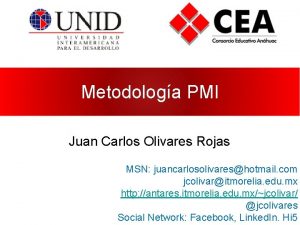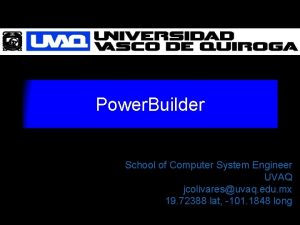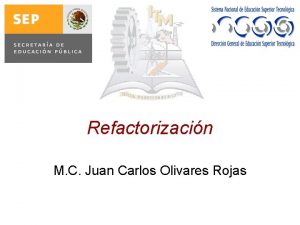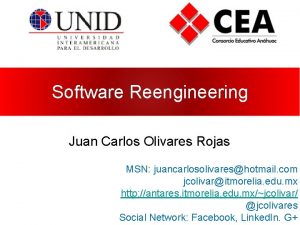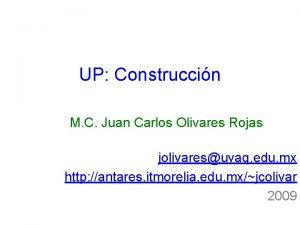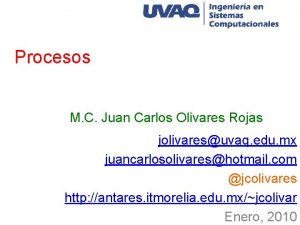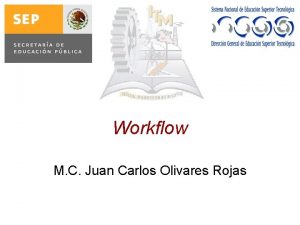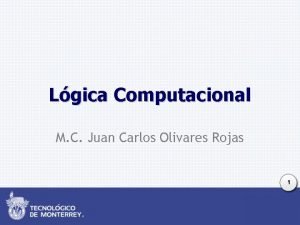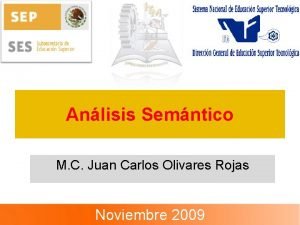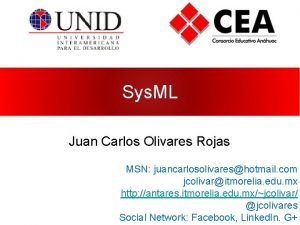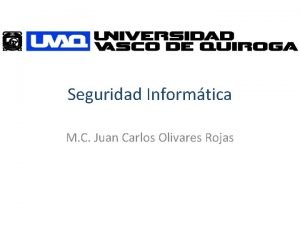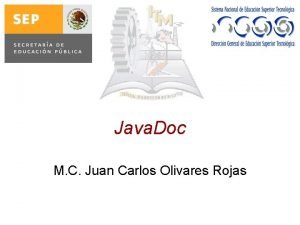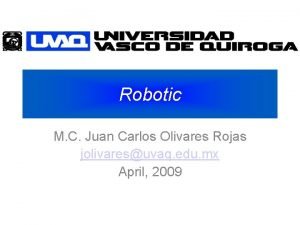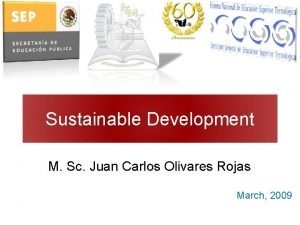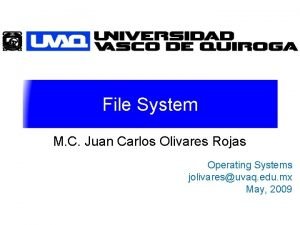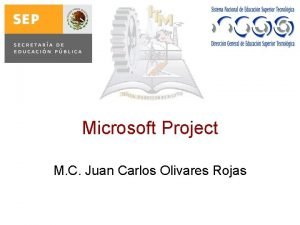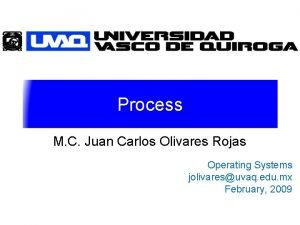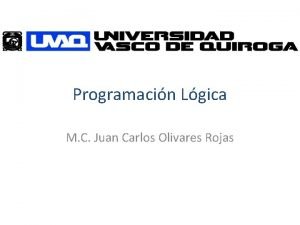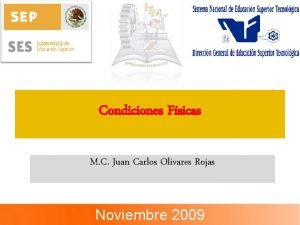AspectOriented Programming M Sc Juan Carlos Olivares Rojas









![Software Development Problems class Book. Store { private Book [] books ; private Partner Software Development Problems class Book. Store { private Book [] books ; private Partner](https://slidetodoc.com/presentation_image_h/b5aa1aac2a2eef33264b8641bde380fa/image-10.jpg)





































- Slides: 47

Aspect-Oriented Programming M. Sc. Juan Carlos Olivares Rojas Department of Computer and System Instituto Tecnológico de Morelia jcolivar@itmorelia. edu. mx http: //antares. itmorelia. edu. mx/~jcolivar/

Disclaimer Some material in this presentation has been obtained from various sources, each of which has intellectual property, so in this presentation will only have some rights reserved. These slides are free, so you can add, modify, and delete slides (including this one) and slide content to suit your needs. They obviously represent a lot of work on my part. In return for use, I only ask the following: if you use these slides (e. g. , in a class) in substantially unaltered form, that you mention their source.

Agenda • Introduction • Aspect-Oriented Programming Fundamentals • Examples • Project of Unit 4

Objectives of the Session • The students will know a new programming paradigm: AOP (Aspect-Oriented Programming). • The students will development a program usin this paradigm or refactoring existing applications.

Software Development Today

Evolución del SW Software Evolution

Evolución del SW Software Evolution

Software Development Problems • A complex system can visualize like as combined implementation of multiple concerns

Software Development Problems class Book { …. . <all things about book> <error handling> … } class Partner { …. . <all things about Partner> <error handling> <access controlling> } class Rent {…. . <all things about Rent> <error handling> <access controlling> }
![Software Development Problems class Book Store private Book books private Partner Software Development Problems class Book. Store { private Book [] books ; private Partner](https://slidetodoc.com/presentation_image_h/b5aa1aac2a2eef33264b8641bde380fa/image-10.jpg)
Software Development Problems class Book. Store { private Book [] books ; private Partner [] partners; public Book. Store() { … public void load( Partner p, Book b) { if valid. Control. Access() then{ // code of the method } else{ throw. Exception(); } } Access Control public void add. Partner(Partner p){ if valid. Contol. Access() then{ // code of the method } else{ throw. Exception(); } } // the rest of the class methods }

Tyranny of the Dominant Decomposition • • Descomposition by Form, Color or size We must choose only one principal model

Tyranny of the Dominant Decomposition • Order by Form • Order by Color

Color-Form Hierarchy • We must elect one principal model. In this case: color and later, form

AOP Definition • AOP was created by Gregor Kickzales and his Research Team at Palo Alto Research Center in 1996. • “ An Aspect is a modular unit that is spreand in another functional units. The aspects exist in the design stage as in the implementación stage…” • An Aspect is a concept that it’s difficult encapsulate clear and easily.

AOP • An aspect is the unit which encapsulate a cross -cutting concern. • AOP promoves the separation of concerns through mechanisms which abstract and compose this concepts troughout the system.

Traditional Structure of a Compiler

Compiling Process in POA

AOP Program Structure Object Models Memory Managment Aspect Sincronization Aspect Program Error Handling ASpect Distribution Aspect …

AOP Program Structure

POA Concepts Join. Pointcut Advice Aspect It’s a well-defined position inside of object-oriented code, for instance, the declaración of a method. It’s a set of conditions applied to a Join. Point, when the conditions are true, it will active and execute an Execution Point asigned at this Point. Cut. It’s a Fragment of Code tha it’s executed when is actived Point. Cut. It’s the combination of Join. Point, Pointcuts and Advices.

An Aspect Definition Aspect Control { Join. Point security. Operations = call s Book. Store. loan & calls Book. Store. add. Partner&. . . Before security. Operations: { if !=(valid. Control. Acces()) then{ throws. Excepcion(); } }

AOP and OOP Relation OOP: common concerns AOP: crosscuting concerns Class A 1 Attb 1 Clase A 2 Attb 3 Attb 2 Method 1 Method 2

OOP Evolution to AOP

POA Advantages • A code less complicated, more natural and more reduced. • More facilities to think about the concerns, since they are separate and dependencies between them are minimal. • An easier code to debug and to mantein.

AOP Tools • Langauges for Programming Aspects: • Aspect. J: A Java Extension. The most popular. • Aspect. C++, Aspect. S, CAESAR. • . NET Languages: Weave. NET, Source Weave.

Class Bank Problem public class Bank { // other declarations public double process. Debit(long id. Account, double amount) { // openning a transaction try { // retrieve account // business validation // business logic associated with debit // persistencia del nuevo estado // traceo del movimiento para auditoria // cierre exitoso de la transacción (commit) return new amount account; } catch (Exception e) { // trace the audit exception // close abnormal transaction (rollback) // relauch the exception in superior layers } } // other business process declarations } Transaction Persistence Traceability

Aspectual Descomposition • Separation of concerns • Aims to isolate cross cutting concerns • Each one of these concerns will be implemented in a separate unit.

Aspectual Recomposition

AOP Bank Version ac cio n an s nc ste ad ilid ab // another business methods declarations } Pe rsi } Tr az // validaciones del negocio // debit business logic return new amount account; ia Tr public double process. Debit(long account, double amount) { ali da d public class Bank { // other declarations

Hello World with Aspects package mx. edu. itmorelia. aspects; public class HW { private String message; public HW() { this. message = “Hello World"; } public void set. Messge(String M){ this. menssage = M; } public String get. Message(){ return this. message; } public void show. Message(){ System. out. println(this. message); } }

Hello World with Aspects package mx. edu. itmorelia. aspects; public class Hello. World { public static void main(String[] args) { HW H; H= new HW(); H. show. Menssage(); } }

Hello World with Aspects package mx. edu. itmorelia. aspects; public aspect Aspect { pointcut messages. To. Print() : call (void HW. show. Message()); before(): messages. To. Print(){ System. out. println(“Hi everybody!"); } after(): messages. To. Print(){ System. out. println(“Chao everybody!"); } }

Alternatives to Aspects • Languages (OO, Componet-Based) • Design Patterns • Reflection

Point. Cut

Point. Cut • When a particular methos is executed: – execution(void Point. set. X(int)) • When a method is invocated: call(void Point. set. X(int)) • When a error handling is invocated: handler(Array. Out. Of. Bounds. Exception) • When the object is actually executed: this(Some. Type).

Point. Cut Examples • When a method belongs to a class: – within(My. Class) • When the Join. Point is in the control flow of a call main method we need to use: cflow • The target point refers to any possible Join. Point 36

Pointcut Designator Wildcards • It’s possible to use wildcards • What do the next instructions do? – – – execution(* *(. . )) call(* set(. . )) execution(int *()) call(* set. Y(long)) call(* Point. set. Y(int)) call(*. new(int, int)) 37

Point. Cut call join points a Line dispatch execution join points • Join. Point Types – Methods – Constructors – Get/Set – Exception Handler

Point. Cut Examples • We can applicate the next operations: or (“||”), and (“&&”) and not (“!”). • Examples: – – target(Point) && call(int *()) call(* *(. . )) && (within(Line) || within(Point)) within(*) && execution(*. new(int)) !this(Point) && call(int *(. . ))

Advice Type • • • before advice after returning after throwing after around advice 40

Parameterized Advice • We can acces to the context of a Join. Point as follow: • pointcut set. XY(Figure. Element fe, int x, int y): call(void Figure. Element. set. XY(int, int)) && target(fe) && args(x, y); • after(Figure. Element fe, int x, int y) returning: set. XY(fe, x, y) { System. out. println(fe + " moved to (" + x + ", " + y + "). "); } 41

Another Example Display * Figure. Element Figure make. Point(. . ) make. Line(. . ) Point get. X() get. Y() set. X(int) set. Y(int) move. By(int, int) 2 Line get. P 1() get. P 2() set. P 1(Point) set. P 2(Point) move. By(int, int) History. Updating

Another Example HTTPRequest get. Cookies() get. Request. URI()(doc) get. Session() get. Requested. Session. Id(). . . Session. Interceptor request. Map(request) before. Body(req, resp). . . Session get. Attribute(name) set. Attribute(name, val) invalidate(). . . HTTPResponse get. Request() set. Content. Type(content. Type) get. Outptut. Stream() set. Session. Id(id). . . 43 Servlet

Project for Unit 4 • Developping a J 2 ME project which implements the Triangle and Ecuation 2 class. • The validation and error handling process must be programming in aspects. • The development team will have two members exlcusively.

Project for Unit 4 • The project consist in two parts: programming (70%) and modelling (20%) (Aspect extension for UML) • The program must be test on a mobile devices (not emulators) • Deadline: Thursday, December 4 at class.

References • Mejía, P. (2008), Programación Orientada a Aspectos, CINVESTAV, México. • Quintero, A. (2000), Visión General de la Programación Orientada a Aspectos. Languages and Information System Department. Informatic and Estadistic Faculty, Sevilla University, Spain. • Rodriguez M. , POA, Gerente Relaciones Académicas, Microsoft Cono Sur

¿Preguntas?
 Juan carlos olivares rojas
Juan carlos olivares rojas Olivares reyes aneurisma
Olivares reyes aneurisma Myelencephalon
Myelencephalon Mesencephalon
Mesencephalon Pack de monserrat olivares
Pack de monserrat olivares Carlos fidel de regules palacios
Carlos fidel de regules palacios Alessandra olivares
Alessandra olivares Jordi olivares
Jordi olivares Juan francisco rojas leo
Juan francisco rojas leo Juan carlos arango barrientos
Juan carlos arango barrientos Juan carlos gualdron
Juan carlos gualdron Juan carlos garcia salas
Juan carlos garcia salas Juan carlos urizar
Juan carlos urizar Juan carlos diaz colchado
Juan carlos diaz colchado Jorge onetti borges
Jorge onetti borges Futsal 1930
Futsal 1930 Juan carlos ceriani futsal
Juan carlos ceriani futsal Iesjci
Iesjci Rafael arturo cepeda peña
Rafael arturo cepeda peña Juan carlos aldave
Juan carlos aldave Juan carlos passano
Juan carlos passano Tabla de conductores electricos
Tabla de conductores electricos Mancha vascular de kiesselbach
Mancha vascular de kiesselbach Irene santolaya torrego
Irene santolaya torrego Carlos juan finlay accomplishments
Carlos juan finlay accomplishments Sistema corticorrubroespinal
Sistema corticorrubroespinal Datrebil significado
Datrebil significado Carlos onetti biografia
Carlos onetti biografia Juan carlos rossetti
Juan carlos rossetti Juan carlos marmolejo
Juan carlos marmolejo Cs 131 stanford
Cs 131 stanford Juan carlos zambrano arciniegas
Juan carlos zambrano arciniegas Juan carlos niebles
Juan carlos niebles Juan juan studio melina
Juan juan studio melina Linear vs integer programming
Linear vs integer programming Perbedaan linear programming dan integer programming
Perbedaan linear programming dan integer programming Definisi integer
Definisi integer Greedy vs dynamic programming
Greedy vs dynamic programming What is in system programming
What is in system programming Mexico criminal justice system
Mexico criminal justice system Mendez rojas class chart
Mendez rojas class chart Martin röjås
Martin röjås Normobúlico significado
Normobúlico significado Patricio rojas quezada
Patricio rojas quezada Karina flores rojas
Karina flores rojas Arteaga rojas rosaura
Arteaga rojas rosaura Alejandra rojas biografia
Alejandra rojas biografia Megan jacques
Megan jacques


